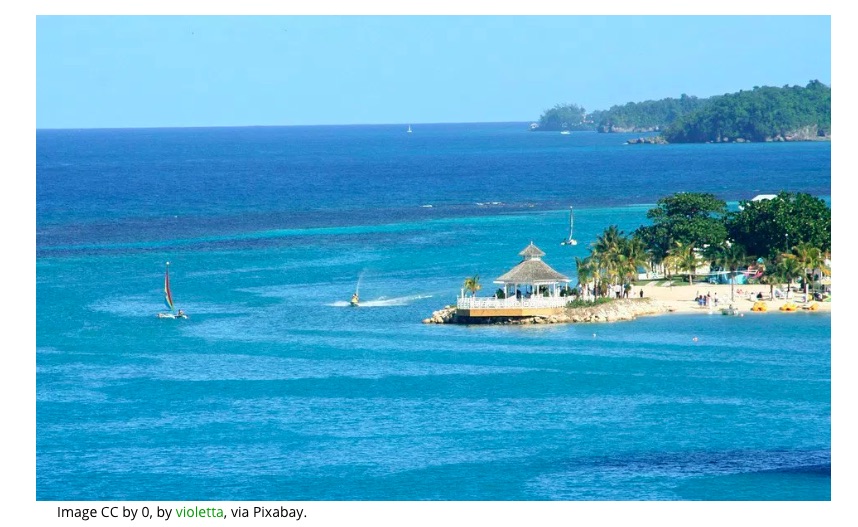Do you know about one of Jamaica’s most stunning natural attractions: the Dunn River Falls?
Dunn’s River Falls are on the north side of the island, not far from a town called Ocho Rios in the Saint Ann Parish. Ocho Rios translates to Eight Rivers, making this the perfect place to find an incredible waterfall.
These falls are almost 200 feet tall and 600 feet long, eventually reaching the Caribbean Sea. They have a natural, stair-like terrace formation, with small lagoons formed between the “steps.” Although the Dunn’s River Falls feature a few human-made changes, they’ve mostly been left to their natural beauty.
This attraction is one of Jamaica’s most beloved features, and even has a fascinating history to go along with it. In this guide, we’ll show you everything you need to know before planning a trip to Dunns River Falls Jamaica.
Dunns River Falls Jamaica
The Dunn’s River Falls offer plenty to do, no matter what kind of experience you’re looking for. Climb the falls if you’re feeling adventurous, or go to the white sand beach at the base of the falls if you’d rather relax. You can even chill out in one of the natural pools that sit along the waterfall’s course.
Because these falls are so much longer than they are tall, they’re perfect for a day hike to the top. It takes about an hour to an hour and a half to climb them.
If you want to stay dry — or don’t feel confident on the uneven rocks — simply use the staircase alongside the falls instead. Dunn’s River Falls are flanked by lush, green trees that offer shade from the sun and keep you cool as you hike.
Many people opt for a tour guide on their visit to the falls. These guides will stop for short photography breaks along the way. There you can take photos of the water flowing over this beautiful, natural stone staircase.
Waterfalls like this are called travertine falls. There are only a handful of these waterfalls in the world, and Dunn River is the only one that meets the Caribbean Sea.
Travertine Falls
Travertine is a type of limestone deposited by hot springs and mineral springs. This stone comes in hues of white, cream, and the rusty tan color of Dunn’s River Falls. Some types of travertine deposits are also known as “tufa,” including the ones at Dunn River.
Tufa deposits are even softer and more porous than ordinary travertine, which means they change and reshape easily. Tufa is the word for travertine deposits from room-temperature water, rather than hot springs.
It’s extremely rare for these deposits to form waterfalls like Dunns River Falls. It takes thousands of years for enough tufa deposits to build up to create terrace-like travertine falls. Most of the time, a mineral or hot spring on a slope forms the foundation for this type of waterfall. As the water moves through limestone rock, it dissolves the rock and picks up calcium carbonate along the way. When the calcium carbonate deposits again, it becomes travertine or tufa, depending on the water‘s temperature.
Travertine limestone has been in high demand for millennia. This is thanks to its beautiful color. Even the Roman Colosseum is partially travertine limestone!
However, one of the most beautiful sights in the world is a natural waterfall made of travertine deposits, never harvested for buildings.
The Dunn’s River Falls are always changing shape, thanks to the same natural forces that created the falls in the first place. Geologists call natural features like these “living phenomenon.” The water is still picking up calcium carbonate and depositing it along the course of the falls. Ever gradually creating new rocky shapes for the water to pass over.
Dunn River Location
Related: Fun Things to do in Ocho Rios
Ocho Rios is the closest town to Dunn’s River Falls, but you can easily access this exciting natural wonder from other popular places, too. The falls are just 90 km from Kingston, and 110 km from both Montego Bay and Port Antonio.
The falls are open every day, but the hours depend on whether or not a cruise ship is in the area. On days without cruise ships, the falls stay open from 8:30 am to 4:30 pm. When a cruise ship is in port, they’re open from 7:00 am to 4:00 pm.
These falls are a major tourist attraction and can get really crowded during the middle of the day! Plan your visit for early in the morning or later in the day to avoid the crowds. Wednesdays tend to be the busiest days for cruise ships, while weekends have less cruise ship traffic but more local visitors.
As a non-Jamaican resident, you’ll pay $20 USD per adult and $12 USD per child to visit. The price is well worth it to see these incredible falls with their interesting history.
Dunn’s River Falls and Park (DRFP) has received a Special Recognition Award as part of the Tourism Service Excellence Awards Programme (TSEAP) for contribution to Innovative Adventure Tourism.
The attraction which has the most certified tour… Read more: https://t.co/DbvUkrKJnb pic.twitter.com/L9nFAhTooq— JamaicaToday.com (@MyJamaicaToday) March 22, 2018
Dunn River Falls History
The Dunn’s River Falls are more than just a natural wonder: they also have a story.
The locals believe that the Dunn River is where the famous “Las Chorreras” battle was fought, when English and Spanish troops vied to take over the island.
Like almost every island in the Caribbean, Jamaica was populated by native inhabitants when Europeans first landed in the late 15th century. Columbus Park, near Ocho Rios, marks the place where some believe Columbus first set foot on Caribbean land.
The natives had thriving cultures and cities, but Europeans quickly decimated the native populations with their foreign diseases and powerful weapons. Although the Europeans successfully stole the land from its rightful inhabitants, they still fought among themselves over who would control which island.
The falls are located in what is now known as Ocho Rios, but the Spanish originally called the area Las Chorreras, or “The Waterfalls,” because of the nearby Dunn River Falls. Some people think the name Ocho Rios came from a British mispronunciation of “Las Chorreras,” since the area doesn’t really have eight rivers.
Related: Top 5 Luxury Hotels in Ocho Rios
The Battle of Las Chorreras
On October 30, 1657, tensions between the Spanish and the English over control of Jamaica came to a head. The English occupied the island, but the Spanish hoped to take back control. During the Battle of Las Chorreras (also known as the Battle of Ocho Rios), though, the Spanish were defeated in their quest.
The English had taken control of the island in 1655, but disease had reduced their power in the two years since. Two of their governors died between 1655 and 1657.
However, the former Spanish governor, Cristóbal Arnaldo Isasi, was still hiding in Jamaica’s hills with the population of escaped slaves that later became known as Maroons. Isasi noticed that the English were losing their grip on power, and requested military forces from Cuba in hopes of reclaiming the island for the Spanish.
The Cuban reinforcements landed at Ocho Rios, bringing the number of Spanish soldiers to 300, plus 100 guerrillas. However, the English sighted the Spanish ships off the coast and decided to attack.
The English brought 900 troops to the north coast, and the battle was fought at Dunn’s River Falls. Isasi’s Spanish forces were quickly defeated, and he ran back to the hills, leaving the rest of his forces to be captured. At the bottom of the falls, the Jamaican Historical Society has placed a plaque to memorialize the battle.
Waterfalls in Jamaica
Although Dunn’s River is among the island’s most popular falls, there are plenty more that you’ll want to see. Here are a few of the island’s best-kept waterfall secrets.
Tacky Falls
In the St. Mary Parish on the northeastern part of the island, you’ll find one of the most natural falls in Jamaica. These falls are best suited for adventurous travelers since it takes an exciting 15-minute hike to get there. However, one of the best parts about these falls is that they’re free from crowds of tourists.
Reggae Falls
Located in St. Thomas Parish, these falls offer an ideal spot for relaxation. In one section of the falls, a natural hot spring flows from the rocks, and locals believe the warm water has therapeutic properties.
Cane River Falls
These falls near Kingston make a perfect swimming hole, with a number of large pools where you can swim and admire the gorgeous natural scenery.
Scatter Water Falls
These small waterfalls might seem unimpressive at first glance, but you’ll be glad you came. At this natural attraction in Port Antonio, you can swim in the falls, then head over to Fox Caves to see incredible formations like underground streams and limestone stalactites.
Reach Falls
These falls are perfect for any nature-loving traveler. Located about 45 minutes from Port Antonio, the falls are surrounded by an ecological sanctuary. Reach Falls offer a habitat for many species of local birds and 23 different kinds of fern! Swim in the naturally heart-shaped pool and let the flowing water give you a massage.
Plan Your Visit to Dunn River Falls
Jamaica boasts some of the best natural wonders in the Caribbean. And, Dunn River Falls always tops the country’s must-see lists. Travertine falls like these are rare, period. But Dunn’s River is one of the only waterfalls in the world that flows right into the sea.
Planning your visit is easy! Just make sure to prepare yourself for the cold water, and pack water shoes for the hike. You’ll also want to bring cash. It is easier for things like tipping your tour guide and buying professional photos. And, cash works better when shopping at the nearby vendors.
Knowing about the unique history and geography of Dunn’s River Falls will make your trip all the more exciting. Are you ready to plan your visit? We can help – check out our tools and resources here.
Featured Image CC by 0, by neufal54, via Pixabay


Hello. I have been searching but have had no luck finding an answer to the following question: after whom is Dunn’s River named? Was there a Mr. Dunn? If so, who was he? Or does the name Dunn refer to something Arawak, etc.? Any guidance would be hugely appreciated!! Thank you!! Best, David
Hey Albert, Happy Holidays.. Great question which is what many have wondered out loud. According to multiple sources of Jamaican history, the original name that was given by The Spaniard was “Las Chorreras” meaning “The Waterfalls”. From Las Chorreras was later changed to “Ocho Rios” or eight rivers. Even though in Ochio Rios we only have four rivers. They are Cave River, Roaring River, Turtle River and of courser Dunn’s River. Hope this was helpful